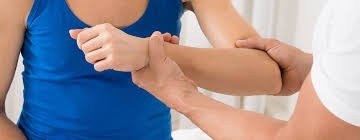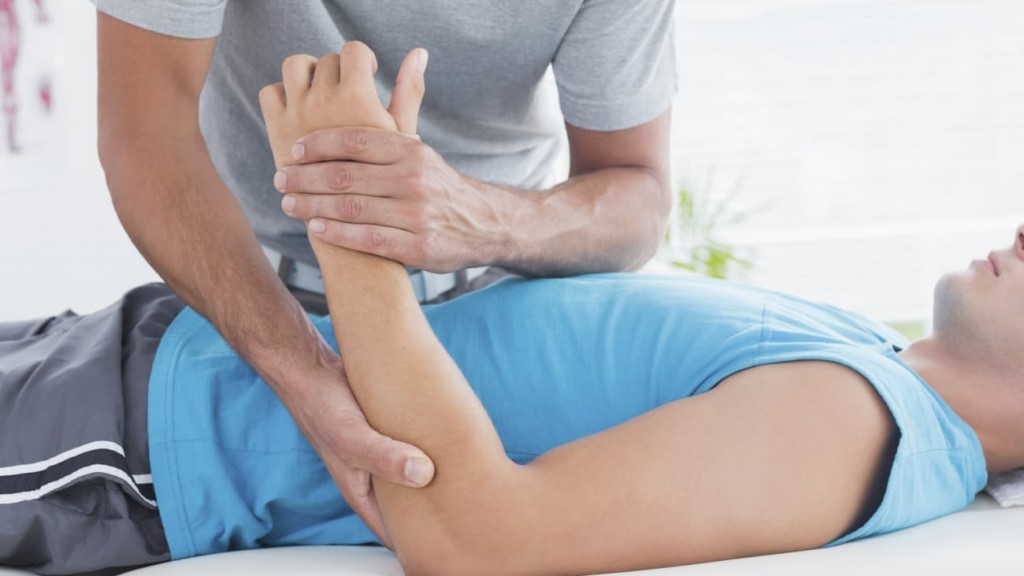
Elbow and arm
Elbow Pain and Disorders.
Physical therapy has a large range of benefits for elbow disorders including pre-surgery and post-surgery rehabilitation, improving mobility after injuries, and relieving pain. One of the many conditions that physical therapy can help with is Tennis and Golfer’s elbow – a common injury, which is also known as tendonitis.
Physical therapy can be a huge help for elbow disorders not only improving the motion of the joint, but also, in time, reducing and eventually eliminating the pain of the injury. We will work with you to identify why your injury might have happened, and work out some exercises that can help you to use your joints more effectively, and take the strain off them.
Exercises they might suggest are aimed at improving blood flow to the tendons, which typically receive much less oxygen than muscles around them, or might be focused on several other things:
-
Exercises that involve stretching and strengthening of the muscles;
-
Massaging using essential oils or ice to reduce inflammation;
-
Stimulating the muscles to improve blood flow;
-
Using straps or taping or braces to provide additional support until your elbow has healed sufficiently.
Pain Relief
If you are looking for pain relief before you visit a physical therapist we have a few suggestions to help ease the pain.
-
ice packs - the normal ice packs you buy at your local market will work. Take the ice pack and rest it on the muscles of the forearm. The coldness of the ice will help ease the pain.
-
light massages - gently massaging the muscles in your foreman will help alleviate some of the pain from elbow’s pain, Also massages help to improve the blood flow to your muscles which will help with circulation.
-
muscle stimulators - this is similar to the light massages; muscle stimulators can help blood flow to your muscles in your foreman. Blood flow is essential for healing because it brings new fresh oxygen in the blood.
These may work for you, but of course, as with any injury, it’s a good idea to visit a physical therapist to get a specific plan, tailored for your injury, as part of a complete plan. Please visit us at iMOVE and we will help.
Common disorders of the Elbow
Biceps Tendonitis: The biceps muscle in a large muscle that works to bend the elbow as well as elevate the shoulder. This muscle is connected to the bones above and below the arm by a thick strong tendon. There are two heads to the biceps muscle, the long head and the short head. With repetitive use, the biceps tendon can become inflamed and painful during use.
Olecranon Bursitis: The bursa is a slippery sac between the skin and the bones at the tip of the elbow. The bursa allows the skin to move freely over the underlying bone. Normally, the bursa is flat. If it becomes irritated or inflamed due to repetitive movement, a condition known as olecranon bursitis develops
Golfer's Elbow: Golfer's elbow (medial epicondylitis) is an inflammatory disorder. Golfer's elbow results when the muscles that flex the wrist are overused. This overuse results in swelling or inflammation of the muscle tendons. Golfer's elbow is named as such due to its common occurrence in people who play the sport. Repetitive flexing of the wrist contributes to this disorder.
Tennis Elbow: Tennis elbow (lateral epicondylitis) is also an inflammatory disorder. Tennis elbow results when the muscles that extend the wrist are overused. This overuse results in swelling or inflammation of the muscle tendons. This inflammation causes pain and discomfort in the outer aspect of the elbow joint.
Elbow Rehabilitation
Stretching and strengthening of the elbow muscles is an important way to recover from injuries and prevent them from reoccurring. Working with your physical therapist is a good idea after an elbow injury. Your PT can help control inflammation and can prescribe specific exercises to help improve your elbow range of motion and strength. Restoring full mobility and normal functional use of your arm is the primary goal of us for elbow problems.
Exercising the biceps and triceps not only increases arm strength but helps stabilize and prevent elbow injuries. Working on exercises for your wrists and forearms can also help keep your elbows working properly. Keeping your shoulders and rotator cuff muscles strong helps bring support to your entire upper extremity. Check in with iMOVE to learn the best strategies to keep your elbows healthy and working properly.
